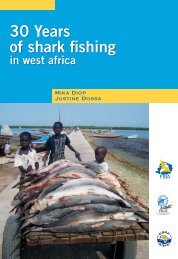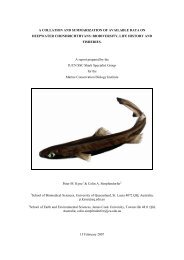Magazine of the species survival Commission specialist Group - IUCN
Magazine of the species survival Commission specialist Group - IUCN
Magazine of the species survival Commission specialist Group - IUCN
You also want an ePaper? Increase the reach of your titles
YUMPU automatically turns print PDFs into web optimized ePapers that Google loves.
<strong>specialist</strong> group exchange<br />
cetaceans, involving more than 100<br />
local and international participants from<br />
governments, NGOs and academic<br />
institutions, took place in Samarinda,<br />
East Kalimantan, Indonesia, from 19 to<br />
24 October 2009 (see www.<br />
ykrasi.110mb.com for <strong>the</strong> full final<br />
report). The event provided an<br />
opportunity for scientists and<br />
conservationists in <strong>the</strong> region to<br />
exchange knowledge and experience,<br />
and to develop recommendations on<br />
how to improve existing protected areas<br />
as well as on how to design and<br />
designate new ones. Discussions<br />
focused on river dolphins and porpoises<br />
in seven countries: Indonesia; China;<br />
Cambodia; Bangladesh; Myanmar; India<br />
and Pakistan.<br />
The total populations <strong>of</strong> Indus and<br />
Ganges River Dolphins number in <strong>the</strong><br />
thousands, but both sub<strong>species</strong> are<br />
Endangered. All riverine populations <strong>of</strong><br />
Irrawaddy Dolphins (called Pesut in<br />
Indonesia) are Critically Endangered,<br />
each numbering fewer than 100. The<br />
Yangtze Dolphin (Baiji) is probably<br />
Extinct, while <strong>the</strong> Yangtze population <strong>of</strong><br />
Finless Porpoises is declining rapidly<br />
and is listed as Endangered on <strong>the</strong><br />
<strong>IUCN</strong> Red List (range-wide estimate in<br />
2006: 1,800).<br />
Although portions <strong>of</strong> some dolphin<br />
rivers in Asia happen to fall inside <strong>the</strong><br />
borders <strong>of</strong> national parks, <strong>the</strong>re are few<br />
examples <strong>of</strong> well-managed areas that<br />
go beyond providing <strong>the</strong>se animals with<br />
just one more layer <strong>of</strong> ‘paper<br />
protection’. Without serious regulation<br />
(if not prohibition) <strong>of</strong> harmful fishing<br />
practices, dolphins or porpoises in a<br />
protected area remain vulnerable to <strong>the</strong><br />
threat <strong>of</strong> bycatch. Water development<br />
projects (e.g. dams and barrages)<br />
outside <strong>of</strong> a protected area can easily<br />
nullify its conservation benefits.<br />
With support from <strong>IUCN</strong>, <strong>the</strong> local<br />
NGO Yayasan Konservasi RASI is<br />
planning a series <strong>of</strong> follow-up meetings<br />
with stakeholders. It is hoped that by<br />
<strong>the</strong> end <strong>of</strong> this year, a protected area for<br />
Pesut will be functioning in <strong>the</strong><br />
Mahakam River in West Kutai (Muara<br />
Pahu sub-district).<br />
O<strong>the</strong>r workshop participants<br />
embraced with great enthusiasm <strong>the</strong><br />
suggestion by Pakistan delegate Abdul<br />
Haleem Khan Marwat that 24 October<br />
should be declared International<br />
Freshwater Dolphin Day.<br />
Randall Reeves<br />
Chair, Cetacean Specialist <strong>Group</strong><br />
Daniëlle Kreb<br />
Contributor and Member, Cetacean<br />
Specialist <strong>Group</strong><br />
Chameleon SG<br />
Indian Ocean secrets revealed<br />
Recently published results from<br />
scientists in <strong>the</strong> Western Indian Ocean<br />
have unear<strong>the</strong>d new secrets about <strong>the</strong><br />
chameleons <strong>of</strong> Madagascar and <strong>the</strong><br />
Seychelles.<br />
In Madagascar, Timon’s Chameleon<br />
(Furcifer timoni) and <strong>the</strong> Tarzan<br />
Chameleon (Calumma tarzan) were<br />
both described recently from <strong>the</strong><br />
island’s rainforests. The discovery <strong>of</strong><br />
F. timoni in Montagne d’Ambre National<br />
Park, a site that has been intensively<br />
surveyed for reptiles, has drawn<br />
attention to <strong>the</strong> hidden biodiversity that<br />
exists within <strong>the</strong> tree canopies <strong>of</strong><br />
Malagasy forests at a time when<br />
unprecedented levels <strong>of</strong> logging are<br />
occurring in <strong>the</strong> north <strong>of</strong> <strong>the</strong> island.<br />
Calumma tarzan was found in two<br />
small rainforest sites in <strong>the</strong> east <strong>of</strong><br />
Madagascar; no reptiles have previously<br />
been recorded in <strong>the</strong>se areas. Small<br />
and isolated native forests in<br />
Madagascar such as <strong>the</strong>se, tend to be<br />
overlooked in conservation planning,<br />
but <strong>the</strong> discovery <strong>of</strong> C. tarzan highlights<br />
<strong>the</strong>ir potentially unique contribution to<br />
biodiversity. One <strong>of</strong> <strong>the</strong> sites,<br />
Ambat<strong>of</strong>otsy, has already been<br />
proposed as a new protected area, and<br />
<strong>the</strong> discovery <strong>of</strong> C. tarzan is now<br />
galvanizing efforts to conserve <strong>the</strong><br />
forest. Ongoing forest loss at <strong>the</strong> o<strong>the</strong>r<br />
site (near Tarzanville) is a major cause<br />
for concern, and raises <strong>the</strong> wider<br />
concern that endemic Malagasy<br />
<strong>species</strong> in o<strong>the</strong>r forests are going<br />
extinct before <strong>the</strong>y are known to<br />
science.<br />
In a study published in <strong>the</strong> journal<br />
Biology Letters, DNA dating techniques<br />
showed that certain African<br />
chameleons and <strong>the</strong> Seychelles<br />
Chameleon are each o<strong>the</strong>r’s closest<br />
relatives, and <strong>the</strong>y shared a common<br />
ancestor approximately 38 million years<br />
ago. Previously, <strong>the</strong> Seychelles<br />
Chameleon was thought to be closely<br />
related to <strong>the</strong> Calumma <strong>species</strong> <strong>of</strong><br />
Madagascar, but <strong>the</strong> results <strong>of</strong> this<br />
study warrant placing <strong>the</strong> Seychelles<br />
Chameleon in a new genus, and its<br />
scientific name is now Archaius tigris.<br />
The uniqueness <strong>of</strong> <strong>the</strong> Seychelles<br />
Tarzan Chameleon (Calumma tarzan). © Frank Glaw<br />
<strong>species</strong> 52 • 17
















